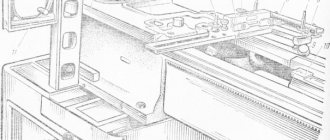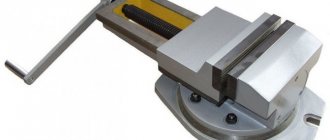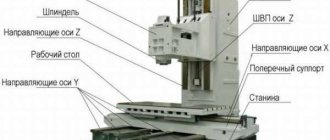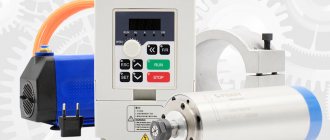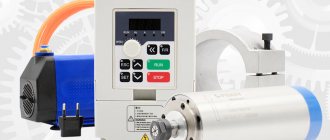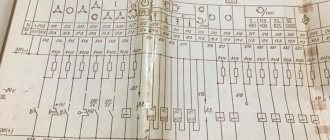16.03.2020
- What is spindle speed and frequency?
- Types of spindles by speed
- How to determine spindle speed
- Calculation of spindle speed of a lathe or milling machine
- Common mistakes when choosing cutting modes
- Recommendations for choosing a cutting mode
When choosing a processing mode for a part, a specialist needs to equally take into account both the performance of the equipment and the cleanliness of the finished surface. The balance between them directly depends on parameters such as feed speed and spindle speed of a lathe or milling machine.
Let us consider the characteristics in as much detail as possible, because they are especially important in the conditions of modern multitasking technology. One single control program can include contour cutting, engraving, and expansion of through holes, including plastic, metal, wood, and composite workpieces that differ in structure, size, and cutting resistance. Therefore, it is simply necessary to correctly regulate the input data - in order to avoid burns, roughness, and premature dulling of the working edges.
We will pay attention to everything related to the setup.
What is spindle speed and frequency?
Let's start with definitions. In the case of feed, this is the dynamics of linear movement - shaft, carriage, portal - per unit of time. It has a direct impact on the amount of material removed, so they try to maximize it, but so that the integrity of the cutter is not compromised. If you set an excessive value of the characteristic, such that the tool cannot withstand in practice, this will result in chips on the blade or deformation of the shank. Excessive heat must also be taken into account: in pursuit of performance, you should not sacrifice the sharpness and life of the edges.
In turn, the spindle rotation speed is the number of revolutions it makes in a certain period of time. The higher it is, the more parts can be processed per unit of time, but the faster the cutter fails. Why? Because the heat generated during the engraving or boring process simply does not dissipate completely and negatively affects all elements of the system in principle. In practice, the value of this parameter is automatically regulated by built-in electronics - in gantry equipment, including CNC equipment, which does not contain structurally complex mechanical components (for example, gearboxes).
Rotational movement of the body, formulas
| During the rotational motion of a rigid body, all elements of its mass that do not lie on the axis of rotation move in a circle. Similarly, a material point located at a distance r > 0 from the axis of rotation also moves in a circle, like any body sufficiently distant from the axis of rotation. Linear displacement Sl, linear speed uL and linear acceleration al during such movement are interconnected by the usual relations for translational motion. |
In addition, these quantities are related in a certain way to the angular displacement ?, angular velocity ? and angular acceleration ?.
| Sl | moving a body along a trajectory, | meter |
| Ul | body speed when moving along a trajectory, | meter/second |
| al | acceleration of a given body when moving along a trajectory, | meter/second2 |
| r | trajectory radius, | meter |
| d | trajectory diameter, | meter |
| ? | angular movement of the body, | radian |
| ? | angular velocity of the body, | radian/second |
| ? | angular acceleration of the body, | radian/second2 |
| f | frequency, | Hertz |
Note: The formulas are valid for constant, instantaneous and average quantities, in all cases of body motion in a circle.
Types of spindles by speed
According to this indicator, all shafts are divided into 3 categories:
- Low-power ones - up to 0.8 kW inclusive - are installed on oversized equipment used in small private workshops to solve simplified household problems; develop from 3 to 9 thousand rpm.
- Medium - from 1.5 to 5 kW - applicable under standard conditions, for processing workpieces made of wood, plastic, soft metals, as well as for engraving; support from 12 to 18 thousand rpm.
- High-performance ones - from 5 kW and above - are intended for industrial equipment designed to solve the most large-scale and serious problems; in general, they reach up to 24 thousand rpm, although this indicator is not always an absolute advantage - the same carbide or thin cutters wear out very quickly at such a speed.
Additional materials
During manufacturing, most specialists are guided by the following indicators as an additional guide. Strength coefficient table:
| Workpiece material | Strength limit | Brinell hardness scale | Coefficient, MPa |
| alloy and carbon steel | varies from 400–1100 units | – | 1500–2600 |
| cast iron and also gray | – | 1400–2200 | 1000–1200 |
| bronze | – | – | 600 |
| silumin | – | – | 450 |
| duralumin | tensile strength from 250 to 350, but often higher depending on the quality of the workpiece | – | 600–1100 |
Material strength coefficient:
| Steel, kg/mm | Indicator value |
| 50,1–60,1 | 1,61 |
| 60,1–70,3 | 1,27 |
| 70,3–80,1 | 1,1 |
| 80,3–90,1 | 0,87 |
| 90,3–100,1 | 0,73 |
| Cast iron, kg/mm | Indicator value |
| 140,1–160,3 | 1,50 |
| 160,1–180,1 | 1,21 |
| 180,1–200,3 | 1,1 |
| 200,3–220,3 | 0,83 |
Cutter life coefficient:
| Duration value, minutes | Index |
| 27–30 | 1,27 |
| 43–46 | 1,11 |
| 57–60 | 1,09 |
| 83–90 | 1,03 |
How to determine spindle speed
To do this, you need to create a technological map for manufacturing the part. The issue is resolved in 5 stages - we will consider each of them.
We pay attention to the source data
It is necessary to determine the following parameters (including specific values of some of them):
- Type of workpiece material – most often it is carbon steel, but cast iron or non-ferrous metal can also be chosen; It is important to understand that the force applied to the surface to remove the desired layer depends on the density and resistance of the metal (plastic, wood).
- The diameter of the part - the scatter here can be quite serious, plus allowances should also be taken into account, the value of which depends on the number of passes and the accuracy class that needs to be achieved. Typically, roughing, finishing, and finishing operations are carried out, each of which reduces not only the degree of roughness, but also the cross-sectional size of the object.
- The length of the workpiece - the longer it is, the more serious the load on the shaft and on the area of its attachment (shank); which means this parameter is also important to take into account.
- The quality of accuracy and the required degree of roughness - precision machining is only possible at high speed and with a CNC that ideally positions the tool and functional units in relation to each other.
Apply the spindle speed formula
According to it, the rotation frequency is found as:
Where:
- V – cutting speed or, in other words, the path that the blade travels per calculated unit of time, measured in m/min;
- d – diameter of the cutter edge, in mm;
- π – 3.14 – constant value.
The performance of a technological operation is influenced by the converter (facilitates changing parameters) and the inverter (partially compensates for the loss of torque during a sharp deceleration of the shaft). But other things being equal, the cross-section of the blade and the design features of the equipment itself come to the fore in terms of importance.
Choosing a tool and machine
Since excessive spindle speed (from the formula and explanations above) accelerates edge wear, it is logical to give preference to a cutter that can withstand the maximum number of revolutions. To do this, it must be made of a wear-resistant alloy or simply remain of a suitable shape. For example, cutters for creating grooves will last longer than those designed for creating flat surfaces.
If possible, be sure to conduct a visual inspection of the tool, carefully checking it for defects: even the smallest defects will develop over time and will definitely speed up wear.
When choosing equipment, consider what tasks it will solve. Threading requires one performance, drilling or forming body parts requires another, the CNC unit can speed up or slow down the work, and so on. The capabilities of an industrial one will be different from what is intended for a home workshop, and the like.
We calculate the spindle speed and cutting mode
A technological map is drawn up, and on its basis - the necessary drawings with informative tables. In this case, the frequency is found by substituting the values into the specified formula. Diameter is a known or at least measurable quantity, and so is movement speed. Based on its indicators, a decision is made on the productivity with which the equipment will operate.
We carry out the final stage
After this, a check is carried out to determine:
- compliance of the actual drive power with the design data;
- reliability of the feed mechanism over a certain period of time;
- strength of the plate and holder - to predict failure;
- completeness of accompanying technological equipment;
- the time it takes to complete one operation, and based on it - the cost of the part.
Based on the results of the trial run, a conclusion is drawn about the effectiveness and relevance of the regime and whether any changes need to be made.
How much cache is enough?
We are talking about the volume of the 1st level cache - its size can fluctuate, you can find models with volumes from 16 to 256 MB. This is high-speed flash memory that speeds up the hard drive, but this speedup is minor (about 5-10%), and does not occur for all operations. For example, when reading sequentially from disk or transferring large files, the difference in the cache will not be noticeable.
You should not chase the maximum value of this parameter - the efficiency of the cache depends more on the cache operation algorithms than on its size, and besides, manufacturers try to select the most suitable cache size for each model.
Also, the cache size depends on the total capacity of the hard drive - for models up to 500 GB, you should focus on 16 MB of cache; for models up to 2 TB, the cache is usually 32-64 MB. Models with a cache of 64 MB or less with a disk capacity of more than 2 TB may not be the fastest options, it’s worth taking this into account.
Calculation of spindle speed of a lathe or milling machine
It often happens that the nominal number of revolutions is known from the passport, but it is not clear how quickly the equipment blade passes its path along the workpiece. In such cases, you just need to use the inverse relationship:
From here it is clear that these two parameters are interconnected, and one expresses the other, and therefore affects:
- Labor productivity – increases if the part turns out to be too expensive to manufacture; however, it is not always possible to significantly increase it in practice, even if the capabilities of special equipment allow this to be done; You remember - operating the tool in too harsh a mode leads to its overheating and premature wear.
- The final degree of surface roughness - the faster the shaft moves, the smoother the plane becomes, but also the greater the load on the blade, so in practice high speeds are not used constantly, but only when carrying out individual operations, most often finishing.
Rotation angle and period of revolution
Consider point A on an object rotating around its axis. When circulating over a certain period of time, it will change its position on the circle line by a certain angle. This is the rotation angle. It is measured in radians, because the unit is a segment of a circle equal to the radius. Another value for measuring the angle of rotation is a degree.
When, as a result of the rotation, point A returns to its original place, it means that it has completed a full rotation. If its movement is repeated n times, then we speak of a certain number of revolutions. Based on this, you can consider 1/2, 1/4 turn and so on. A striking practical example of this is the path that a cutter takes when milling a part fixed in the center of the machine spindle.
Common mistakes when choosing cutting modes
Very often, novice turners and millers do not coordinate speeds - this results in stress concentration on the edge, which means it increases the likelihood of tool breakage at such “critical” points and causes other problems.
There are two classic situations:
- Maximum speed with slow feed - this seriously reduces the quality of processing. In addition, the cutter will not remove the chips, but will only press on the surface, first only grinding it, and then causing burns; at the same time, not only acting idle, but even losing strength, because bending of the edge will be observed.
- The opposite situation results in the blade removing too much material and at the same time experiencing excessive stress, resulting in chipping and leaving scratches and other defects on what should be a smooth plane.
Therefore, in practice, it is necessary to calculate the spindle speed for each technological operation and, based on the results obtained, to correlate the feed rate in order to ensure not only speed, but also accuracy and safety of the process. Moreover, all values can be taken within a certain range - there is always room for tolerances. Remember that long-term use of the tool is a consequence of the correct approach, while unexpected breakdown is the result of mistakes made.
And universal advice - carry out processing in several stages: first rough, removing as much unnecessary metal as possible, then finishing, more slowly, and finally finishing - to polish the smallest irregularities.
Power of rotating objects
To calculate such a system, use the formula:
N = M * w = (2π * M* n)/60,
Where:
- M – moment of force;
- w – angular velocity characterizing rotation;
- n is the number of revolutions that an engine or other device makes in 60 seconds.
The information provided is used taking into account the intended purpose and actual conditions. Thus, in thermodynamics it is necessary to remember that the efficiency of the system depends on the ambient temperature. The heat loss of the heater is estimated by the corresponding power per unit surface area. The same is done when solving mechanical problems to calculate thrust, efficiency, and other operating parameters. As a rule, it is necessary to compensate for friction with a special coefficient.
In electrical circuits, current limits the resistance of the conductor. For short distances at low power, careful calculations are not necessary. However, the highway project necessarily contains the corresponding calculations. Based on the results obtained, conclusions are drawn about average annual economic indicators. It should be remembered that it is necessary to take into account the distortions that reactive loads add when working with alternating voltage.
Recommendations for choosing a cutting mode
Let's consider a few more common cases and those standard and practice-tested solutions that are acceptable and rational to use in these situations.
Lathe spindle speed is too high
Even the minimum amount for equipment can be excessive. Most often this is observed when they try to process some material of increased strength with a large-diameter blade. You can do the following:
- Replace the tool with one that is made of carbide metal and has a coating that protects it from heating at elevated temperatures.
- Adopt HSM technology, according to which the first pass is performed along the entire length of the edge, and subsequent passes only a quarter; This will speed up the production process without increasing wear or the likelihood of breakdowns.
- Reduce the diameter of the cutter, which will slow down the dynamics of the circumferential movement.
Feed speed is too slow
If the drive consistently does not provide the required labor productivity, you can take one of the following solutions:
- Take a cutter with a larger cross-section - the advice seems banal, but in practice, many beginners neglect such a seemingly simple solution.
- Reduce the number of shaft revolutions until the power reaches the lower tolerance limit, that is, follow the “slow but sure” principle.
- Taking a tool with fewer teeth is important for viscous materials, as it makes it easier to remove chips; Instead of three passes, give preference to one, and thereby triple the feed to the cutter.
Waste build-up when milling aluminum parts
This metal has a low melting point and therefore remains in significant quantities on the surface of the heated edge. Beginners often solve this issue by slowing down the technical process, but this significantly reduces labor productivity, and the production of blanks is more expensive.
Therefore, you need to do something differently, namely, review the composition of the cutting fluid, and if it is normal, then use it in a larger volume. If the equipment, in principle, does not consume coolant, it is necessary to implement one of the alternative solutions, for example, removing chips using a vacuum method or periodically blowing the contact area with compressed air.
Deep Hole Machining
This category includes those whose depth is 6 times greater than the diameter. In this situation, it is not so much the number of spindle revolutions that is important (the formula for calculating it has not changed), but rather the specifics of the operation. To prevent the blade from breaking or moving off the axis, you should:
- use a drill with parabolic flutes, not a milling cutter;
- supply coolant constantly and under pressure - the lubricant can effectively flush out chips;
- periodically remove the tool - just to remove the removed material;
- solve the problem sequentially, using two cutters of different diameters - go through the first half with the narrower one, the second with the wider one;
- speed up the process so that the waste flows in a continuous spiral.
How to mill grooves
To do this, it is necessary to correctly correlate the depth and width of the chips with the productivity of the equipment. You already know how to calculate spindle speeds, which means you can easily calculate the speed if you have data on the diameter of the cutter.
Therefore, let's focus on other patterns. For example, based on the fact that immersion into a part contributes to a more uniform distribution of loads, but it also increases the bending of the edge and impairs waste removal. Well, increasing the width leads to slower processing, which means production losses.
The optimal combination in this case is found experimentally: it is necessary to test the equipment in a variety of modes and find the one that can best meet the release conditions. An important point: the test workpiece must be identical to the “real” one in everything, including the material used. Only this approach will ensure the necessary accuracy of the results.
Now that you know everything about the issue, down to the unit of measurement of spindle rotation speed (rpm), you can calculate in advance what speed is needed to perform current technological operations and select the appropriate equipment. Responsible manufacturing plants design their machines taking into account the current needs of enterprises, including in the basic package a variety of tools, solutions and technologies for processing a wide variety of workpieces made of metal, plastic, and wood. This is exactly the approach professed by Izhevsk “Sarmat”, in whose catalog you will find a number of worthy models - reliable, easy to use, high-performance, economical.
